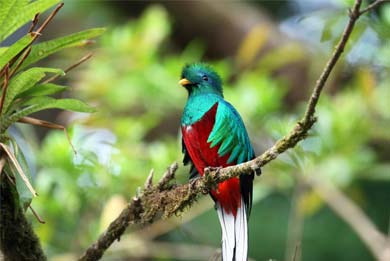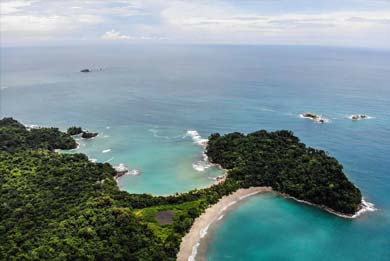Nature and Wildlife of Costa Rica Tour

Costa Rica possesses one of the richest biological heritages on earth concentrated within its small territory. This is due to its tropical location, position as a land bridge between North and South America, and its varied geography dominated by a series of mountains that divide the nation from northwest to southeast.
Costa Rica is bordered by the Pacific Ocean to the west and the Caribbean Sea to the east. The internal landscape is a mixture of wet eastern lowland plains, seasonally arid hot pacific lowlands, lush rainforests, cool mountain forests, and windy seasonally frost-bitten mountain peaks. The central valley near the geographic center of the nation enjoys a mild, spring-like climate year-round. This is the cultural and economic heart of the country and where the nation’s four largest cities (including the capital of San José) and the main international airport are located.
Due to the nation’s small size, a traveler starting from the urban center of the Central Valley can reach most of these diverse habitats or either coast in just a two to four hour drive. The nation possesses several volcanoes with mild activity of simmering vents and hot rivers emerging from around their bases.
Wildlife abounds in Costa Rica. Visit the right locations and you can easily encounter monkeys, iguanas, colorful birds, and butterflies. With more determination, and with the help of a guide and some luck, you can see a greater variety of wildlife, including scarlet macaws, resplendent quetzals, toucans, parrots, poison dart frogs, sloths, and many others. The marine coastal habitats enjoyed by naturalists, sports enthusiasts, and beach goers also have a rich aquatic fauna and ocean waters at the beaches are a warm and pleasant 78-82 ˚F throughout the year. The sunsets in the summer afternoons are often beautiful too.
Nature & Wildlife Activities
Birding and Birdwatching
One of the reasons for Costa Rica’s extraordinary bird life is the country’s great variety of habitats: rain forests, mangrove swamps, beaches, cloud forest, rivers, etc. And any two of those ecosystems, with their resident bird species, are often only a short distance apart.
With almost 850 species of birds -more than total of what North America has- packed into an area half the size of Kentucky, it’s hard not to become enthused about the variety of feathered creatures one encounters in Costa Rica. And we have experienced nature guides who make any bird watching expedition something amanzing.
The country’s exemplary System of National Parks and Protected Areas provide more than ample stomping grounds for birders, but just about anywhere you look in Costa Rica, you spot interesting avian species. Even some of the hotels in the San Jose area have such colorful critters as blue-grey tanagers, great kiskadees and crimson-fronted parakeets in their gardens.
However, those interested in bird watching will want to see the resplendent quetzal, which lives in the cloud forests of Monteverde, Los Santos region and the Central Volcanic Mountain Range, and the equally spectacular scarlet macaw, which can be seen on the Osa Peninsula or the area around the Carara Biological Reserve.


Whale Watching
Being really close to Whales in their natural habitat is one of the most incredible experiences a person can have and Costa Rica is the best place for whale watching.
Humpback Whales arrive in Costa Rica at the beginning of winter, but there are groups from the north and from the south, so when the southerns came, the northers have just left, that’s why visitors can watch Humpback Whales almost year round.
Although it is possible to see humpback whales along many parts of Costa Rica’s Pacific Coast, they tend to congregate in the Southern Pacific but in some areas in northern Costa Rica, like Guanacaste visitors may still be lucky.
Turtle Nesting
Costa Rica is a privileged land, and some of its privileges are the beautiful turtles arriving to nest on its beaches on both the Pacific and Caribbean shores. Five species and one subspecies of sea turtle live and nest in Costa Rica: leatherbacks, hawksbills, loggerheads, Olive Ridleys, green sea turtles and black sea turtles.
Tortuguero National Park in the Caribbean is one of the most popular destination to see turtles and it was created to protect the Green turtle, since this nesting area is the most important in the Western Caribbean.


Botanical Gardens
Because the biodiversity in this magical country, Costa Rica has interesting options to nature lovers who want to explore its flora. There are several excellent walks through the gardens and a vast selection to places to visit. For example Lankester Botanical Garden has the largest collection of orchids in the world, with nearly 15,000 cataloged specimens, about 1,000 species, most of which are native to Central America.
National Parks
Costa Rica is a privileged land, and some of its privileges are the beautiful turtles arriving to nest on its beaches on both the Pacific and Caribbean shores. Five species and one subspecies of sea turtle live and nest in Costa Rica: leatherbacks, hawksbills, loggerheads, Olive Ridleys, green sea turtles and black sea turtles.
Tortuguero National Park in the Caribbean is one of the most popular destination to see turtles and it was created to protect the Green turtle, since this nesting area is the most important in the Western Caribbean.


Hanging Bridges
Hanging Bridges attraction is a combination of suspended bridges stretch over river ravines and give visitors unique views into and above the forest canopy. Among the vegetation which includes palms, ferns, bromeliads, and tall trees, you may encounter wildlife including toucans, poison dart frogs, and monkeys.
Private Nature Reserves
In addition to Costa Rica’s excellent system of national parks, it is the country’s organization of private nature reserves that helps preserve Costa Rica’s tropical ecosystems and their biodiversity.
There are more than 213 private nature reserves in Costa Rica. These reserves help to preserve the country’s natural resources, and promote sustainable, earth-friendly growth. Many private nature reserves function as buffer zones for national parks, allowing for the free movement of species, so the parks do not become “biological islands”.
















